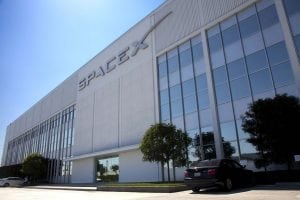[Via Satellite 01-21-2015] Google and Fidelity have confirmed an investment of approximately $1 billion in SpaceX, powering the second large-scale Low Earth Orbit (LEO) satellite communications constellation announced in a mere five days. Together the two new investors own slightly less than 10 percent of SpaceX — a company founded by serial entrepreneur Elon Musk, CEO and chief engineer, who said he has no intention of making the company public until it is regularly launching to Mars.
In a statement, SpaceX said the funding will bolster space transport, reusability and satellite manufacturing, the latter of which remained largely a rumor until announced at a Jan. 16 presentation at the Seattle Center. The event was closed to media, but a video recording of Musk’s speech was uploaded to YouTube by an attendee.
Joking that the talent-laden city’s residents are too stubborn to move to Los Angeles, Musk announced the creation of “SpaceX Seattle,” which will become the nucleus of the company’s satellite development program. SpaceX plans to build and launch a constellation of approximately 4,000 satellites in LEO to provide worldwide access to broadband with a latency of 20 to 30 milliseconds. To meet the cost of building human-rated residencies on Mars, Musk anticipates the project will create a significant source of revenue for infrastructure on the Red Planet.
SpaceX hopes to launch version one of the satellite constellation in roughly five years. Musk acknowledged previously underestimating the timing for massive undertakings like this, and noted that the first version would not feature all of the capabilities of later iterations. The full constellation would handle about 10 percent of the world’s business and consumer direct traffic, and more than half of the long distance traffic. New, more advanced satellites would be launched about every five years.
Musk also said there are important differences between SpaceX’s project and the undertakings of Teledesic, a failed company that originally planned a constellation of 840 LEO satellites in the 1990s. He attributed the company’s undoing to not planning for terrestrial network improvement, and the challenge of getting a satellite signal through buildings and other infrastructure.
“In the case of Teledesic, they were trying to talk to phones and that gets back to that problem of a roof-penetrating situation. Particularly when stuff is coming from space, if you’re in a skyscraper, it’s got to go through 27 floors to reach you. It’s not going to happen,” Musk said at the conference. “In the case of Teledesic there were some environmental issues there.”
Tim Farrar, president of TMF Associates, cautioned that there were other bigger challenges to Teledesic that SpaceX is also likely to face.
“Teledesic didn’t proceed because the technology wasn’t there to meet the business plan. The biggest issue was really in terms of their terminals. You couldn’t make terminals at a cost effective price that were going to be suitable. Low-end users (small businesses or consumers) were the primary target for Teledesic, and having mechanically steered dishes that track satellites across the sky was an expensive business then and it’s still an expensive business now,” Farrar told Via Satellite.
Musk envisions the terminals would cost between $100 and $300 dollars each, depending on the version. The goal would be to make the broadband from SpaceX satellites accessible to people in both developed countries and those with limited resources. According to Farrar, this technology is still a ways off, especially at the proposed price point.
“That’s a challenging target, which is pretty difficult to achieve with a mechanically steered antenna, if not impossible. That’s an enormous challenge and I still don’t know that we have a comprehensive answer to that. Kymeta is heading in that direction, but we have not got a working two-way system up and running at this point in time in terms of end user terminals,” Farrar said.
SpaceX expects the mammoth satellite constellation to cost roughly $10 to $15 billion dollars overall. Musk described the project as being similar to “rebuilding the Internet in space,” adding that satellites constitute as much or more space-based activity as rockets. While the primary goal of the constellation will be satellite communications, Musk said there could be other applications in Earth science and space science that the company could potentially offer to others.
For Google, the SpaceX investment follows its earlier acquisitions of Skybox Imaging and Titan Aerospace. The company’s continued interest in aerospace technologies has fueled speculation about its own telecommunications ambitions, and how satellite fits into them.
“Google is looking to provide Internet access anywhere in the world, and they’ve tried out a large number of options, whether it’s balloons or drones,” said Farrar. “Satellite is clearly another one of those potential options and, if Musk can fulfill his ambition to be able to manufacture satellites at low cost, then that would be a good way forward.”
With more satellites announced this year than in any prior, these plans could stir up action among incumbent operators.
“The new competition could be a [Merger and Acquisition] M&A catalyst,” Andrew Spinola, senior analyst at Wells Fargo wrote in a Jan. 20 research note. “To the extent that SpaceX and OneWeb can improve cost per bit economics for satellite broadband, the existing players will need to respond.”
The post SpaceX Satellite Project Boosted by $1 Billion Google, Fidelity Investment appeared first on Via Satellite.
